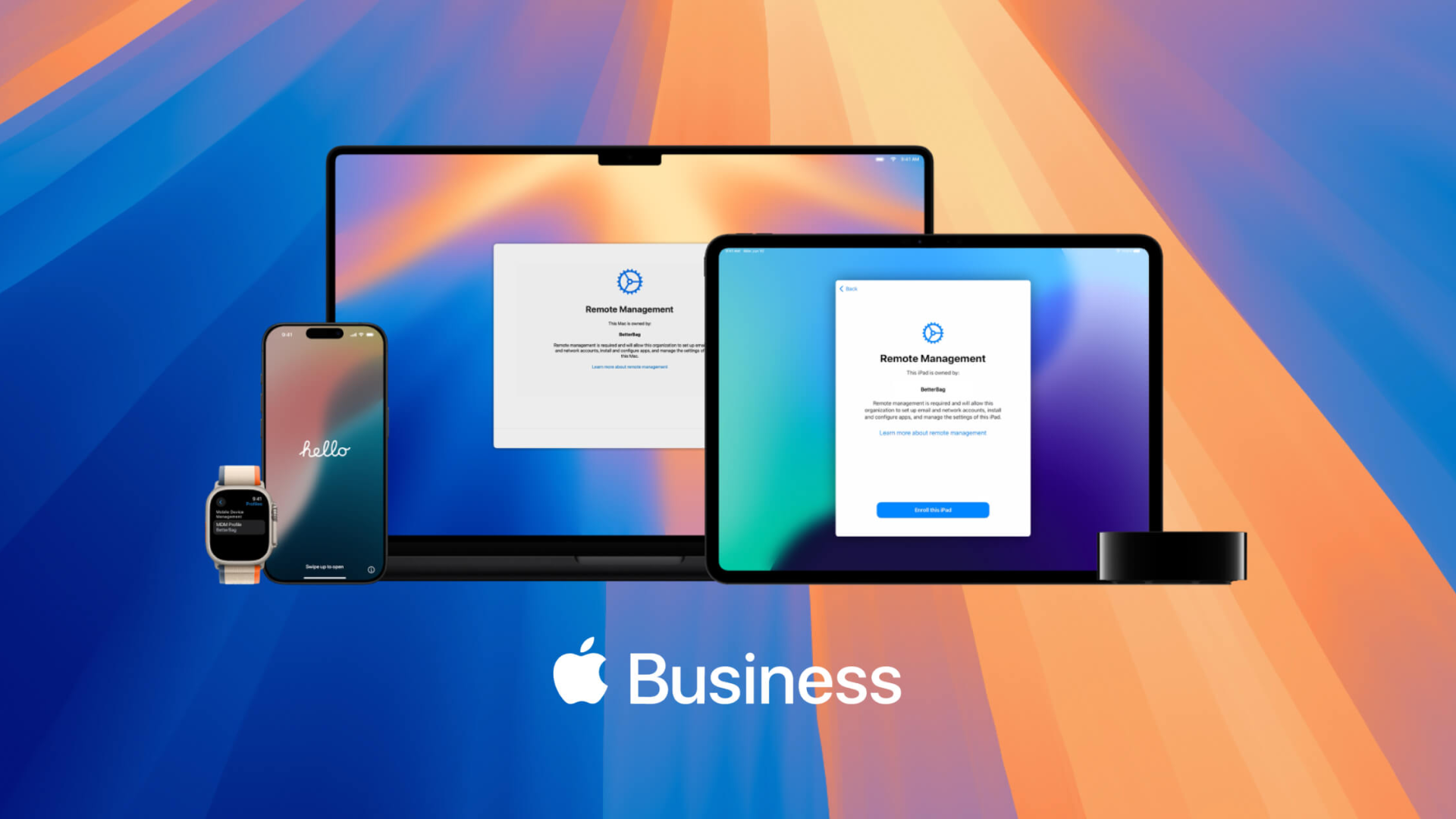Managing devices in a large enterprise isn’t just about keeping equipment functional — it’s about ensuring security, efficiency, and seamless user experiences. As companies adopt more Apple devices — from iPhones and iPads to Apple Watch and even Apple Vision Pro — the need for effective device management becomes more critical than ever.
This article explores how Apple’s management options—like Apple Business Manager, Apple School Manager, and third-party MDM solutions—can help your business stay secure, compliant, and easily managed. We’ll walk through the key features, best practices, and future trends in Apple enterprise device management, helping you make smarter decisions for your organization.
Understanding Apple device management
Device management in an enterprise setting involves overseeing the lifecycle of your company’s hardware and software. It’s about making sure devices are configured correctly, secure from threats, and compliant with company policies—without burdening your IT team. When it comes to Apple devices, this process requires specific tools and strategies tailored to their ecosystem.
What does device management entail?
At its core, device management includes the setup, configuration, monitoring, and maintenance of hardware and software — such as iPhones, iPads, Apple Watch, and even Apple TV. It involves tasks like enrolling devices into management systems, deploying apps and updates, securing data, and controlling access. The goal? To enable your team to work productively while protecting your corporate information.
Benefits of managing Apple devices effectively
- Enhanced security: By implementing consistent security policies, encryption, and remote wipe capabilities, businesses can safeguard sensitive information, especially when managing personal Apple accounts combined with managed devices.
- Increased efficiency: Automated enrollment and configuration reduce manual setups, allowing employees to start working faster.
- Regulatory compliance: Proper device management ensures adherence to industry standards and legal requirements, which is crucial if handling personal or client data.
- Better user experience: Users get streamlined onboarding, easier access to resources, and faster support, allowing them to focus on their work.

Common management challenges
Despite the benefits, managing Apple devices in a business context isn’t without obstacles:
- Complexity of deployment: Setting up hundreds or thousands of devices manually can be overwhelming.
- Device security: Ensuring all devices are secure, especially with personal data involved, can be tricky.
- Keeping software updated: Managing timely updates across devices, especially in remote teams, requires automation.
- Device loss or theft: Protecting corporate data on lost or stolen devices needs robust remote management.
Understanding these challenges is the first step toward choosing the right tools and strategies. In the next section, we’ll explore Apple’s native management tools designed to simplify and optimize this process.
Apple’s built-in management tools
Apple provides several native solutions that make managing its devices in an enterprise environment easier and more secure. These tools are designed to streamline onboarding, configure devices efficiently, and ensure ongoing management and security.
Apple Business Manager (ABM)
Apple Business Manager is a web-based portal that helps organizations deploy and manage Apple devices at scale. It simplifies the process of setting up new devices by allowing automatic enrollment during initial setup, which means devices are configured with the right settings right out of the box.
- Key features and functions:
- Device enrollment: Devices can be automatically enrolled into management systems without manual configuration.
- Device provisioning: Pre-configure settings, apps, and content remotely.
- Managed Apple IDs: Create special Apple accounts linked to your organization for employees, which help manage access and control permissions.
- Content distribution: Easily push apps and books to devices without needing individual Apple IDs.
- How it simplifies onboarding and device deployment:
Using ABM, your IT team can assign devices to users before they even receive them, speeding up onboarding. It reduces manual work and ensures all devices are configured in accordance with security policies from the moment they turn on for the first time.
Managed Apple IDs
Managed Apple IDs are special accounts for business and education use. They allow better control over user data, device access, and app management.
- Use cases:
- Apple ID for business use: Employees can access cloud services while IT maintains control over permissions.
- User groups: Assign permissions by groups to manage large teams efficiently.
- Data privacy: Personal data remains under user control, separating personal and business information for security and compliance.
Apple deployment programs
Apple offers several deployment programs that help organizations deploy large numbers of devices smoothly:
- Device Enrollment Program (DEP): Automates device registration and configuration, enabling “zero-touch” setup.
- Volume Purchase Program (VPP): Distributes apps and books in volume, simplified via MDM solutions.
- Content management: Use these programs with a Mobile Device Management (MDM) solution to control app updates, security settings, and restrictions.
How these tools work together
These native avenues—ABM, managed Apple IDs, and deployment programs—create a seamless experience for configuring devices, managing user groups, and deploying content. They work best when integrated with a third-party MDM solution, which we’ll explore next, to add further control and automation capabilities.
Mobile device management solutions for Apple devices
While Apple’s built-in tools provide a strong foundation, many organizations rely on third-party MDM solutions to unlock full control over their Apple ecosystem. MDM software acts as the command center, allowing IT teams to configure, secure, and support devices remotely.
What is MDM?
Mobile Device Management (MDM) software enables organizations to manage their fleet of Apple devices through a centralized platform. It supports tasks like setting security policies, deploying apps, configuring settings, and troubleshooting issues—all without physically touching devices. MDM integrates tightly with Apple’s native tools, providing an extra layer of control and automation.
Key features of an effective MDM solution for Apple devices
- Automated device enrollment: Enroll devices automatically at setup via Apple Business Manager or Apple School Manager.
- Device configuration profiles: Create profiles to configure Wi-Fi, VPN, email, restrictions, and security settings remotely.
- App distribution and management: Push apps directly to devices, manage licenses, and update software seamlessly.
- Remote support and troubleshooting: Lock, wipe, or troubleshoot devices remotely, ensuring minimal downtime.
- User groups and profiles: Assign specific policies, apps, and restrictions to user groups for tailored management.
- Content and data management: Control access to corporate data and prevent personal data from mixing with business data.
Popular third-party MDM providers
Many organizations choose from a range of reputable MDM options to meet their needs, such as:
- Jamf: The leader in Apple device management, offering extensive automation, customization, and security features tailored for Apple devices.
- VMware Workspace ONE: Provides unified endpoint management, supporting a broad spectrum of devices, including Apple, with strong security controls.
- Mosyle: A cost-effective option designed specifically for Apple environments, with a focus on education and enterprise markets.
How MDM solutions complement Apple’s native tools
While native tools are great for basic deployment and management, third-party MDM solutions add value by providing:
- Deeper automation capabilities
- More granular control over device features
- Enhanced security policies
- Sophisticated remote support features
Example scenarios of device management using MDM
- Onboarding new employees: Automatically configure all necessary apps, accounts, and security settings when a device is assigned.
- Managing user groups: Create separate profiles for executives, remote workers, or field teams to deliver tailored settings.
- Security enforcement: Wipe or lock devices if stolen or compromised to protect company data.
- Content deployment: Push critical updates or apps securely, without user intervention, across thousands of devices.
In essence, combining Apple’s native management tools with a robust MDM solution provides the flexibility, security, and scalability needed to manage Apple devices effectively at an enterprise level.
Best practices and strategies for Apple enterprise device management
Managing Apple devices efficiently requires more than just deploying tools — it’s about adopting proven best practices that maximize security, reduce downtime, and simplify processes. Here are some key strategies to keep in mind:
Automate device enrollment and configuration
Manual setup is time-consuming and error-prone, especially as your fleet grows. Automating device enrollment through Apple Business Manager or Apple School Manager ensures devices are configured correctly from day one. This approach enables automated device enrollment, making devices easily managed right out of the box.
- Use deployment profiles to pre-configure network settings, restrictions, and security policies.
- Automate app and content deployment via MDM solutions.
Manage apps and content securely
Apps are essential for productivity, but their management must be secure. Use your MDM or Apple Business Manager to distribute apps professionally and securely.
- Turn on app restrictions to prevent unauthorized downloads.
- Use volume purchasing programs for bulk app deployment.
- Regularly update apps and software to patch vulnerabilities and add features.
Ensure compliance with security standards
Security should be baked into your device management strategy. Enforce strong passcodes, encrypt device data, and restrict personal use where necessary.
- Use managed Apple IDs to control access to corporate resources.
- Apply security policies to prevent data leaks, such as disabling screen captures or restricting cloud backup.
- Set strict policies around personal data handling to maintain compliance with data privacy regulations.
Provide remote support and troubleshooting
Remote device management is crucial, especially with increasingly distributed teams. Using MDM, IT support can troubleshoot issues, wipe, or lock devices quickly, reducing downtime.
- Enable real-time remote support for fast resolution.
- Automate periodic software updates to keep devices secure and running smoothly.
- Use user groups to tailor support and configurations based on roles.
Regular updates and maintenance
Keeping devices and management tools up to date is vital for security and performance.
- Schedule automatic updates for iOS, iPadOS, and other Apple OSes.
- Use MDM to monitor device health and compliance.
- Periodically review user accounts, device inventory, and access controls to prevent unauthorized use.
Additional Tips
- Educate users about security best practices and the importance of device security.
- Create clear policies for device usage, privacy, and incident response.
- Document workflows to streamline onboarding, offboarding, and device recovery.
Adopting these strategies ensures your Apple device management remains scalable, secure, and aligned with your business goals. Effective management isn’t just about technology — it’s about implementing a proactive approach to support your growth.
Real-world use cases and case studies
Understanding how other organizations leverage Apple enterprise device management can provide valuable insights into best practices and tangible benefits. Here are some examples illustrating how different companies successfully implement Apple management tools:
Example 1: A large retail chain streamlines device deployment
A national retail chain managed thousands of iPads and Apple TVs used in stores nationwide. By integrating Apple Business Manager with an MDM platform like Jamf, the company automated device enrollment, configuration, and app distribution. This streamlined onboarding of new devices ensured that all store employees had access to the latest point-of-sale apps and inventory systems immediately upon setup.
- Outcome: Significantly reduced setup time, minimized configuration errors, and improved store employee productivity. The company also maintained tighter control over point-of-sale devices, enhancing security.
Example 2: A startup empowering remote teams
A fast-growing startup with a remote workforce used MDM solutions to manage iPhones, iPads, and MacBooks. By configuring user groups within their MDM platform and using Apple School Manager, they assigned customized settings for different teams — sales, development, and support. Automated onboarding and offboarding improved security, while remote troubleshooting minimized downtime.
- Outcome: Enhanced security, quicker onboarding, and a more consistent user experience across the organization. Employees could use Apple devices confidently, knowing they were secure and easily managed.
Example 3: Enhancing compliance and data security
A financial services firm deployed managed Apple IDs to separate personal data from corporate information. They used Apple’s native tools combined with third-party MDM to enforce encryption and restrict data sharing. Regular software updates and device monitoring ensured ongoing compliance with strict industry regulations.
- Outcome: The firm improved its data security posture, reduced the risk of data leaks, and maintained compliance with industry standards such as GDPR and FINRA.
The takeaway
These examples show that regardless of industry or size, strategic use of Apple’s native management tools, combined with third-party solutions, can significantly enhance operational efficiency, security, and compliance. The key lies in choosing the right tools, automating processes, and adopting best practices tailored to your organization’s needs.
Future trends and considerations in Apple enterprise device management
As technology advances, so do the opportunities and challenges in managing Apple devices at an enterprise level. Staying ahead of upcoming trends can help your organization adapt quickly and maximize the benefits of Apple’s evolving management ecosystem.
Upcoming features in Apple management tools
Apple continues to enhance its native management solutions. Expect improvements such as:
- Enhanced automation: More intelligent onboarding and configuration workflows, reducing manual effort.
- Deeper integration with third-party MDM solutions: Creating a more seamless management experience across platforms.
- Refined device security features: Strengthening device encryption, authentication, and threat detection capabilities to combat increasingly sophisticated cyber threats.
Integration of AI and automation
Artificial intelligence (AI) is poised to reshape device management:
- Proactive security: AI-powered threat detection and anomaly alerts can help prevent breaches before they happen.
- Automated troubleshooting: Machine learning algorithms may predict device issues and recommend fixes, reducing downtime.
- Personalized experiences: Tailoring device settings and content based on user behavior to improve productivity.
Security enhancements and threat mitigation
With remote work and IoT devices expanding, security remains a top concern. Future updates from Apple are likely to include:
- Advanced endpoint protection
- Improved remote wipe and lock capabilities
- Better encryption and privacy controls
Impact of 5G and remote work
The rollout of 5G connectivity and the shift toward remote and hybrid work models continue to influence device management strategies:
- Faster, more reliable connections enable real-time management and troubleshooting.
- Greater reliance on cloud-based management platforms for device configuration, support, and security.
- Increased demand for flexible, easily managed devices that can adapt to evolving work environments.
Strategic considerations
To prepare for these trends, organizations should:
- Invest in scalable MDM solutions capable of adapting to new features.
- Continuously train IT teams on emerging tools and best practices.
- Prioritize security and compliance in all device management activities.
By staying informed and agile, your business can leverage future innovations to streamline operations, enhance security, and support growth in an increasingly digital world.
Building a future-ready Apple ecosystem
Managing Apple devices in an enterprise environment involves more than just deployment; it’s about building a secure, efficient, and scalable system that supports your business objectives. Apple’s native tools like Apple Business Manager and Managed Apple IDs provide a strong foundation for automating onboarding, configuring devices, and maintaining security. When combined with robust third-party MDM solutions, organizations can unlock even greater control and automation.
FAQs
1. What’s the difference between Apple Business Manager and an MDM?
Apple Business Manager (ABM) is Apple’s web portal for zero-touch deployment and content licensing; it assigns devices and Managed Apple IDs. An MDM (Mobile Device Management) platform is your day-to-day control center: it pushes configuration profiles, apps, and security policies; enforces passcodes and encryption; and performs remote lock/wipe.
How they work together: ABM hands devices to your MDM via Automated Device Enrollment (ADE) so iPhones, iPads, Macs, Apple TV—and even Apple Watch in certain workflows—arrive supervised, auto-enrolled, and policy-compliant out of the box.
2. How can we securely onboard and offboard Apple devices at scale, especially for remote teams?
- Zero-touch setup: Use ABM + ADE so devices enroll into MDM during Setup Assistant—no manual IT touch.
- Standard profiles: Preconfigure Wi-Fi, VPN, email, certificates, and restrictions with configuration profiles.
- Role-based access: Apply user/group policies (executives, field, retail) for tailored apps and permissions.
- Rapid offboarding: Trigger remote lock/wipe, rotate credentials, and revoke access tokens immediately; keep an auditable trail.
- Logistics: Pair MDM workflows with a courier/return process and clear employee comms; track status in your asset system.
3. How do we balance BYOD privacy with security on iPhones and iPads?
Use User Enrollment (Apple’s privacy-preserving BYOD model). It creates a managed partition for corporate data while leaving personal photos, apps, and iCloud untouched. Combine with Managed Apple IDs to:
- Gate corporate apps behind managed identities and per-app VPN
- Apply data-loss prevention (open-in controls, copy/paste limits) only to work data
- Allow selective wipe of corporate content without affecting personal data
Result: strong security and compliance without overreaching into employees’ personal space.
4. What should we look for in an enterprise iOS MDM vendor?
- Deep Apple support: Full ABM/ADE, supervision, User Enrollment, Declarative Device Management, and same-day iOS/iPadOS update support
- Security controls: Encryption enforcement, passcode policies, compliance rules, jailbreak/root detection, remote lock/wipe
- Lifecycle automation: App licensing (VPP), update orchestration, OS deferrals, patch compliance dashboards
- Scalability & UX: Clear admin UI, robust APIs/integrations (IdP, SIEM, ITSM), and reliable support across regions
- Reporting & audits: Real-time inventory, compliance exports, and automated remediation for drift
If you’d like a turnkey path, Esevel combines Apple native tooling with managed MDM operations—zero-touch onboarding, policy governance, remote support, and secure offboarding—for distributed teams.







